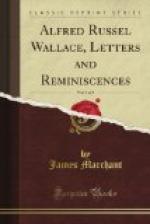The utter lack of initiative, or even ordinary interest, in making the most of the opportunities lying at hand, struck him again and again as he went from place to place and was entertained hospitably by hosts of various nationalities; until at times the impression is conveyed that apart from his initial interest as a naturalist, a longing seized him to arouse those who were primarily responsible for these conditions out of the apathy into which they had fallen, and to make them realise the larger pleasure which life offers to those who recognise the opportunities at hand, not only for their own advancement but also for the benefit of those placed under their control. All of which we find happily illustrated during his visit to Sarawak, in the Malay Archipelago.
The whole of these four years was crowded with valuable experiences of one sort and another. Some of the most toilsome journeys proved only a disappointment, while others brought success beyond his most sanguine dreams. At the end of two years it was agreed between himself and Bates that they should separate, Wallace doing the northern parts and tributaries of the Amazon, and Bates the main stream, which, from the fork of the Rio Negro, is called the Upper Amazon, or the Solimoes. By this arrangement they were able to cover more ground, besides devoting themselves to the special goal of research on which each was bent.
In the meantime, Wallace’s younger brother, Herbert, had come out to join him, and for some time their journeys were made conjointly; but finding that his brother was not temperamentally fitted to become a naturalist, it was decided that he should return to England. Accordingly, they parted at Barra when Wallace started on his long journey up the Rio Negro, the duration of which was uncertain; and it was not until many months after the sad event that he heard the distressing news that Herbert had died of yellow fever on the eve of his departure from Para for home. Fortunately, Bates was in Para at the time, and did what he could for the boy until stricken down himself with the same sickness, from which, however, his stronger constitution enabled him to recover.
Perhaps the most eventful and memorable journey during this period was the exploration of the Uaupes River, of which Wallace wrote nearly sixty years later: “So far as I have heard, no English traveller has to this day ascended the Uaupes River so far as I did, and no collector has stayed at any time at Javita, or has even passed through it.”




